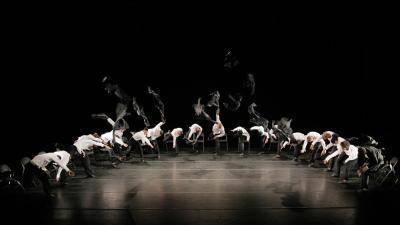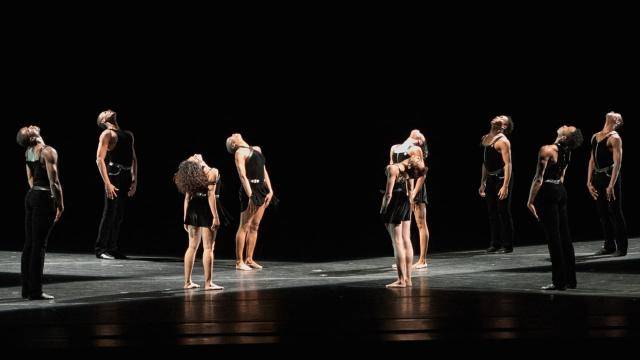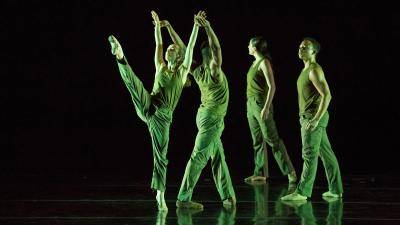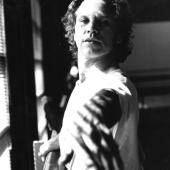“Power of Ailey”, one of three themed repertory programs playing at the Music Center is mostly a male affair. Men dominate all of the pieces on the program, including Naharine’s “Minus 16”, in which the women are suited up as men. But powerful dancing proved not enough to set this awkwardly conceived program free from posey, often pretentious dance-making that looked like the real deal but whose content ultimately delivered little.
The best of the mix was Hofesh Shechter’s all male urban tribal fantasy, “Uprising” (2006), restaged for Ailey in 2014. Riding on a current of street dance idioms that hugged the floor, the company looked like alt B Boys, a band of brothers, engaged in wrestling, horseplay and a competitive bonhomie. But the undercurrent of political tension never finds a real purpose until the ending, which delivers a “to the barricades” metaphor burdened with a trite tacked on summation. It didn’t help that final pile up of bodies, with one dancer waving a small handkerchief-sized red flag, was set to a cryptically edited few bars of Mozart (the K. 550 Minuet). The rest of the music by Schechter and Vex’d leaned heavily on pounding percussion and ambient noise. That music was a good match for the hazed air and harsh white lighting, some of it projected from a head high bank of canisters pointed at the audience. It was cool and hip, but also much less of an adventure than its title promised.

The most hopeful moment of “Uprising” came in the form of unison dancing from the cast of seven men. Dressed in street clothes they melded contemporary and street dance idioms with running and stalking as they prowled the striped down stage. The on stage vibe mined some of the same vein as BalletBoyz’ choreography for “Fallen” (recently seen at the Ahmanson) which managed to paste much more meaning into a similarly themed work.
Opening the program was Ulysses Dove’s 1987 “Episodes”. Dove has created memorable works for Ailey and other companies. This was not one of them. The mostly sex-segregated casts of five men and four women seem hemmed in by diagonal lighting patterns on stage and mechanical or forced interactions. The piece got off to a rough start with precarious turns and other near misses. Some of it, especially the stop and go action of the prepared turns makes what could pass as a contemporary work look old fashioned. “Episodes” too comes with a superimposed ending as the barefoot dancers tap out rhythms on the floor before walking away in silence. The percussion and electronic sound score was by the film composer Robert Ruggieri.

The other big work on the program was Ohad Naharine’s “Minus 16”. More patched together choreography than a stand-alone work--it borrows from other Naharine works made between 1992 and 2005--it has at its heart a superbly layered dance odyssey based on the Hanukkah carol “Echad Mi Yode’a” choreographed for the entire company seated in a semi-circle on folding chairs, and a riveting duet set to Vivaldi’s eerie liturgical score from the “Nisi Dominus”. One of the great pleasures of “Minus 16” is its sense of hijinks and its goofy musical eclecticism. It opens and closes with lounge music and in the middle traverses folk carols, the Baroque, a bit of Dick Dale and “Over the Rainbow”. By the time the audience participation bit rolls around the messages of the sublime Vivaldi duo are a distant memory, especially for those audience members who have been selected to join in for the last section. It’s Euro trash, but pretty good Euro trash and good fun as well.

Sandwiched between “Episodes” and the first intermission was David Parsons novelty work “Caught” for a solo male dancer and strobe lighting. It achieves some spectacular effects by suspending the dancer in mid-air. Danced by Kirven Douthit-Boyd, the soaring jumps combine a quirky beauty with real danger. Two other programs “Soul of Ailey” and “Joy of Ailey” continue this week. Company dancer Matt Rushing may be making a play for “Son of Ailey” with his new work “Odetta” based on songs by that famed 60’s folksinger and civil rights activist. You can see “Odetta” on the programs for tonight or Sunday.



